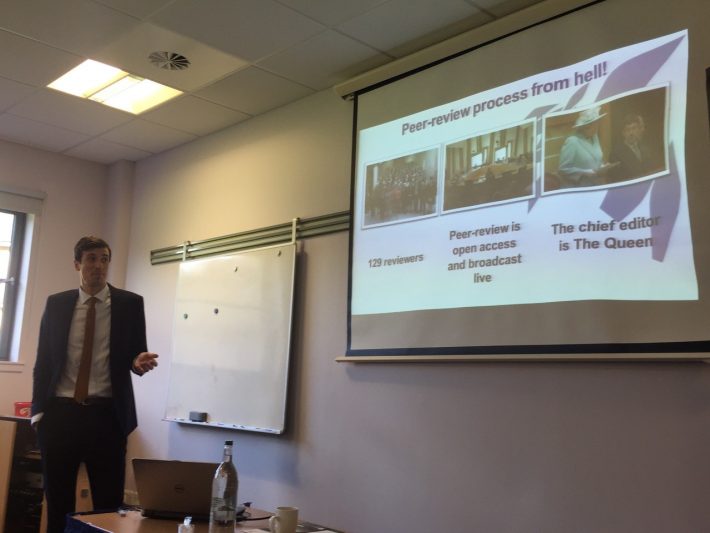Understanding the science-policy interface in Scotland
Emily Schofield summaries her key take home messages from the Scottish Policy Group’s 2017 Policy Training workshop held in Stirling on the 9 November.

Since starting my PhD I’ve become increasingly interested in policy and particularly how Scottish environmental policy differs from UK wide policy. Therefore, I attended the BES Scottish Policy group training day ‘Understanding Scottish Policy’ at Stirling University. The small workshop was a really informative and enjoyable day. Here are some of my highlights organised into what I found to be the key take home messages.
We are all stakeholders
Science policy can have two meanings – policy about science strategy/funding or science feeding into policy decisions. Therefore, there is a need to be clear about what we mean when we talk about science policy. This workshop focussed on the role of research in informing policy decisions. As all of our projects are environmentally based, our research should have a role in shaping Scottish biodiversity and environmental policy. But how can we do this? Daphne Vlastari from Scottish Environment LINK was on hand to explain where in the process of putting together and passing environmental legislation researchers can get involved. This includes at the consultation stage, answering calls for evidence, through to post-legislative scrutiny where monitoring can be used to validate or improve a policy. And it’s easier than you might think! Engaging with Scottish Parliament is much easier, as it is more accessible, than at Westminster, making it easier to engage policymakers directly. This means that in Scotland there is a unique opportunity to closely link policy to research.
The nitty-gritty of policy
Damon Davies from the Scottish Parliament Information Centre (SPICe) then presented the process of developing and passing a policy into legislation. He used a really nice analogy with writing and publishing a paper. Except with legislation there are 129 reviewers and the Queen is the chief editor!

It was a really good way of explaining how a bill is written, reviewed by a committee, amended, reviewed by Parliament and then hopefully passed. It makes me glad the peer review process isn’t a live broadcast as the bill scrutiny is in Parliament! There are many opportunities for early career researchers to get involved with policymaking: providing evidence in consultations as well as SPICe internships (POST at Westminster) to write policy briefings on current issues. Debbie Bassett from Scottish Natural Heritage (SNH) then impressed the need for post legislation scrutiny; this involves using evidence from studies after a policy is implemented to ensure existing policies are working and making changes when they are not. This reinforces the need for researchers to be involved throughout the lifetime of a policy.
Science based policy successes
Jeremy Wilson from the RSPB gave us some examples of how science based policy decisions in Scotland have been successful in protecting and promoting biodiversity. One strategy that has been successful is protecting the corn bunting (Emberiza calandra), which has been in decline for a number of decades in Scotland, due to modern agricultural practices. A package of simple measures including compensating farmers for later silage cutting and leaving strips of grain unharvested for winter food were introduced. This has been followed up by monitoring which has shown how population numbers have increased.
A more general science-based policy success has been agri-environment schemes implemented over the last 30 years. For birds, they have included the introduction of field margins, skylark nesting patches in fields, and later meadow mowing, all backed up by subsidies. Most measures have shown that these policies have been successful in maintaining and enhancing biodiversity. Hearing these stories from people who worked on forming and implementing these policies really gave me an insight into how science can practically feed into policy.
Practical policy
The day was also crammed with really useful ways we can all get involved in policymaking. This includes asking why are you in the room – who am I representing, am I presenting evidence or advocating and what is my key message? Having a chance to think about these things beforehand should help to allay fears about engaging with policymakers at events or meetings. That and remembering policymakers are people too!
There is a need to make our research relevant to policymakers and the policies that are being reviewed or revised in Parliament at the moment. Policy briefings and parliamentary bulletins are an excellent way of knowing which policies are up for review and where our research can feed into these. However, the most important piece of advice from the day for me was the importance of storytelling. Putting research into a story is important to engage policymakers (and the public), and to get research into policy and ultimately more research funding! Certainly one we can all think about is how to turn our research into a story.
We were given the chance to put all this great advice into practice with an ‘elevator pitch’ – 30 seconds to explain the research and policy recommendations from a recent paper to our very own ‘Dragons Den’. It is certainly an art and more tricky than you might first think! From listening to the pitches it was evident that using non-technical terms, having a clear message, making links to existing policies, and enthusiasm are vital for success. It’s difficult to boil down one paper to 30 seconds let alone 3-4 years of research but to catch the imagination of the policymaker this is what we need to do!
The day was packed with information and advice about Scottish environmental policy – I now can’t wait to get involved in more policy events!
Like what we stand for?
Support our mission and help develop the next generation of ecologists by donating to the British Ecological Society.